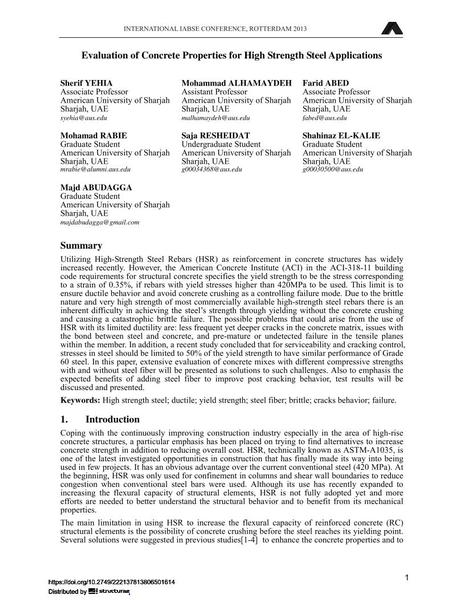Evaluation of Concrete Properties for High Strength Steel Applications

|
|
|||||||||||
Détails bibliographiques
| Auteur(s): |
Sherif Yehia
Mohammad AlHamaydeh Farid Abed Mohamad Rabie Saja Resheidat Shahinaz El-Kalie Majd Abudagga |
||||
|---|---|---|---|---|---|
| Médium: | papier de conférence | ||||
| Langue(s): | anglais | ||||
| Conférence: | IABSE Conference: Assessment, Upgrading and Refurbishment of Infrastructures, Rotterdam, The Netherlands, 6-8 May 2013 | ||||
| Publié dans: | IABSE Conference, Rotterdam, May 2013 | ||||
|
|||||
| Page(s): | 360-361 | ||||
| Nombre total de pages (du PDF): | 8 | ||||
| Année: | 2013 | ||||
| DOI: | 10.2749/222137813806501614 | ||||
| Abstrait: |
Utilizing High-Strength Steel Rebars (HSR) as reinforcement in concrete structures has widely increased recently. However, the American Concrete Institute (ACI) in the ACI-318-11 building code requirements for structural concrete specifies the yield strength to be the stress corresponding to a strain of 0.35%, if rebars with yield stresses higher than 420MPa to be used. This limit is to ensure ductile behavior and avoid concrete crushing as a controlling failure mode. Due to the brittle nature and very high strength of most commercially available high-strength steel rebars there is an inherent difficulty in achieving the steel’s strength through yielding without the concrete crushing and causing a catastrophic brittle failure. The possible problems that could arise from the use of HSR with its limited ductility are: less frequent yet deeper cracks in the concrete matrix, issues with the bond between steel and concrete, and pre-mature or undetected failure in the tensile planes within the member. In addition, a recent study concluded that for serviceability and cracking control, stresses in steel should be limited to 50% of the yield strength to have similar performance of Grade 60 steel. In this paper, extensive evaluation of concrete mixes with different compressive strengths with and without steel fiber will be presented as solutions to such challenges. Also to emphasis the expected benefits of adding steel fiber to improve post cracking behavior, test results will be discussed and presented. |
||||
